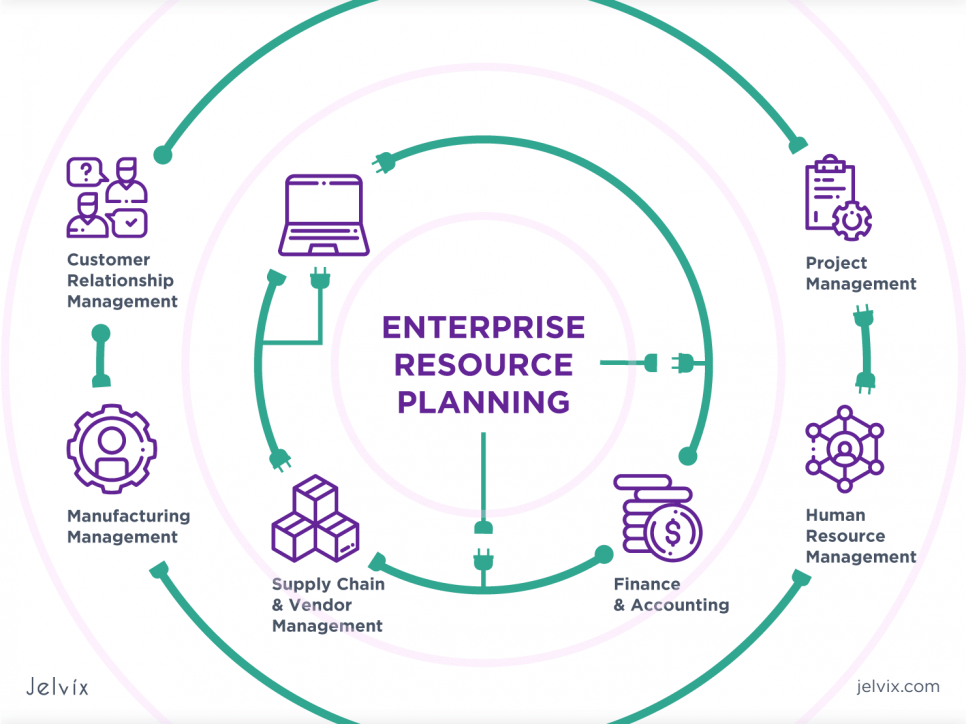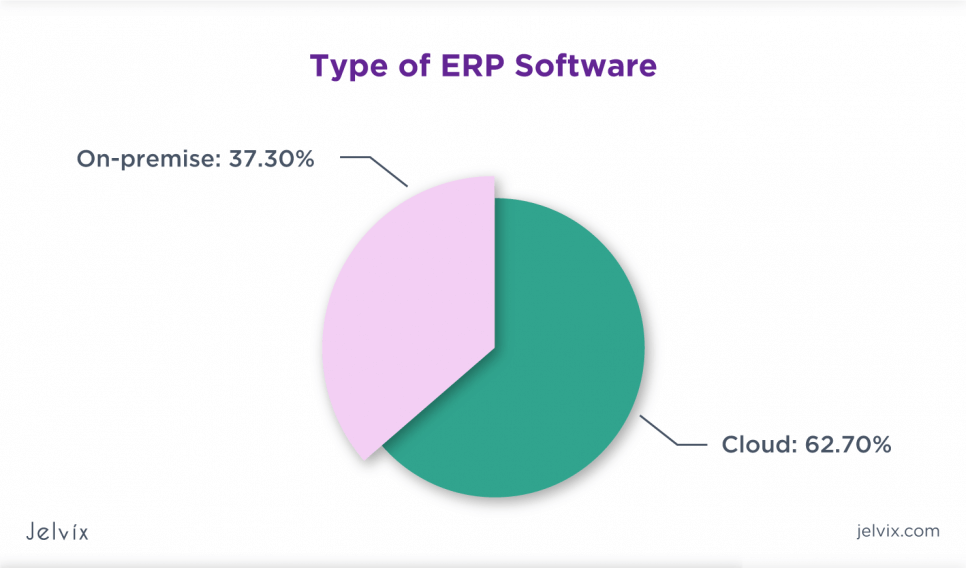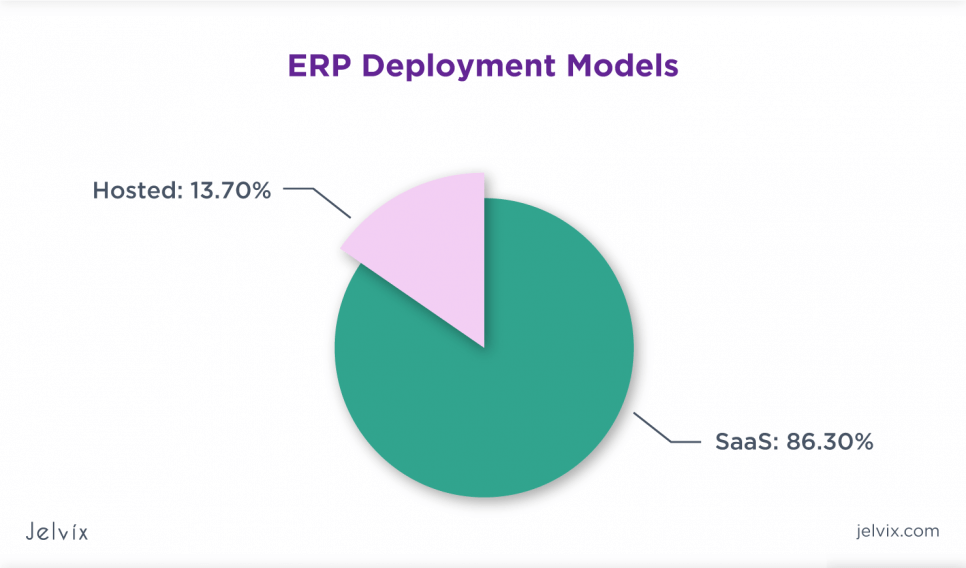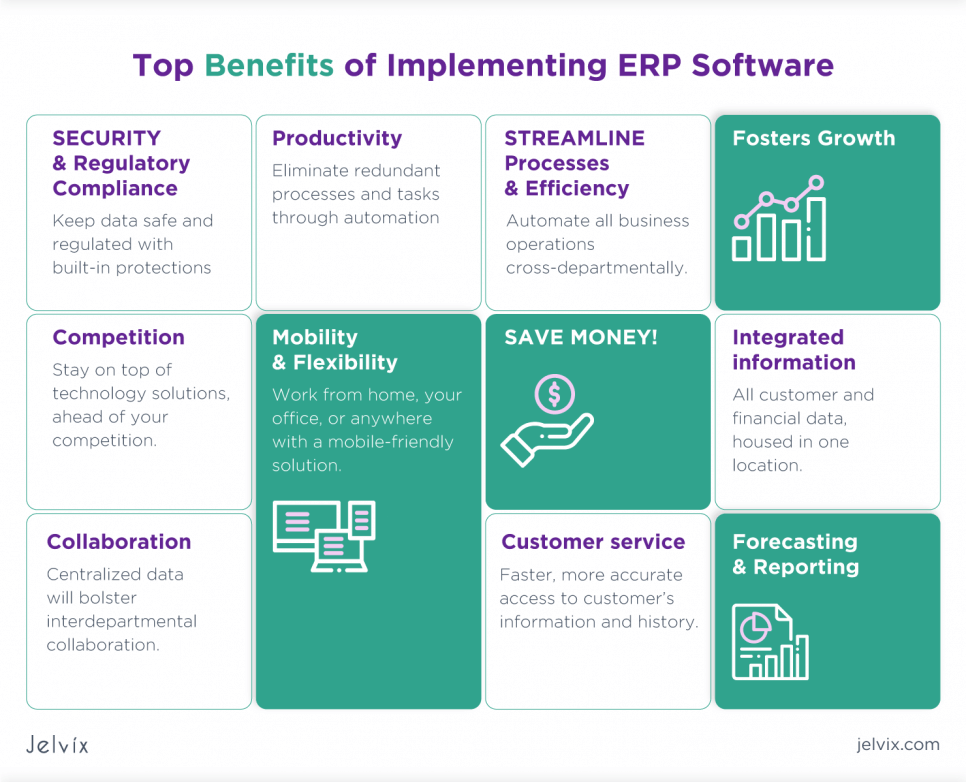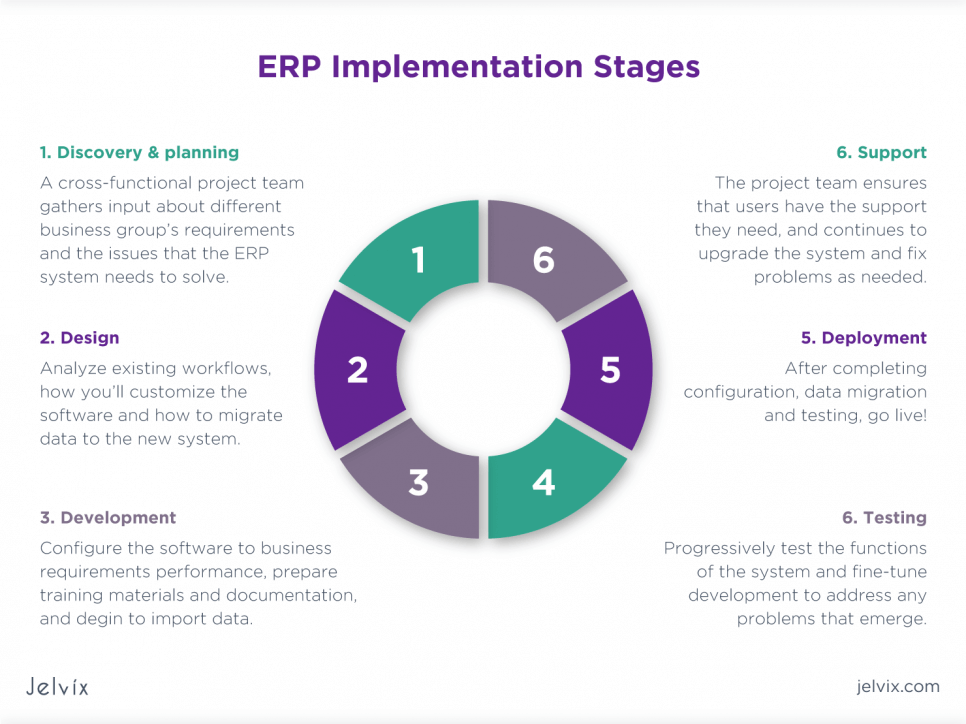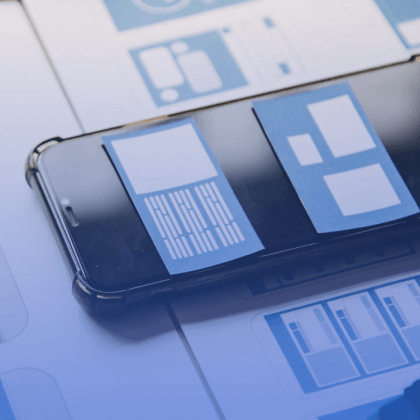In 2020, the global Enterprise Resource Planning (ERP) market was estimated at $94.71 billion. By 2024 it expects to reach $97.15 billion.
ERP is not a novelty in the tech world and has already been used for several decades. Now it goes through a new era of market development. The adoption of ERP systems increased due to the growing popularity of cloud-based technologies and the mobile app market. The companies are investing in cloud computing and mobile development. This causes the demand for ERP systems that can be accessed from a smartphone.
Today, the ERP software industry has a tight connection with advanced technologies like IoT, AI, Big Data analytics. Their development generates new opportunities for ERP and advances its adoption by small and medium-sized companies.
By 2024, North America is going to hold the biggest cloud ERP market share. Its wide adoption explains this by new industries. The businesses that already use ERP switch from an on-premise system to a cloud-based one. Asian countries are also expected to face the highest growth due to a large number of small&medium companies adopting ERP solutions for their business management.
What is ERP Integration and Why Your Business Needs It?
Companies of all sizes use ERP software for automating different aspects of a business. An ERP system powers customer information, products, finance, logistics – everything. It acts as a centralized hub to manage critical parts of your business and keep the data from the different departments in one place.
This facilitates coordination of the work of different departments, increases security, regulates information access and sharing, and automates some routine processes.
Functions of ERP
ERP software is a complex system, and companies from different industries require different specific functionality. Yet, let’s consider some basic features useful for any company regardless of its business area.
- Finance management & accounting
- Storing the documents and templates
- Tracking the company’s money flows
- Automated calculation, making simple operations
- Preparing financial reports
- Procurement & inventory management
- Keeping the lists of approved vendors and goods
- Automated generation & sending the purchase orders
- Shipment tracking
- Manufacturing
- Planning production management, tracking that the company has the necessary materials and production capacity
- Real-time status of production of the different goods
- Calculating the production time, supply-demand comparison, production planning
- Order & Warehouse Management
- Integration with warehouses, distribution centers, retail stores
- Real-time tracking of order delivery to the customer
- Preventing order losses
- Planning the work according to the expected order volume
- Cutting shipment expenses
- Supply Chain Management
- Tracking each stage in the supply chain: sub-suppliers & suppliers, manufacturers & distributors, retailers & customers
- Managing returns, refunds, and replacement of goods
- Integration with procurement, manufacturing, order & warehouse management
- Customer Relationship Management (CRM)
- Storage of customer & prospect information and communication & purchase history
- Sales management, lead generation
- Handling marketing campaigns
- Workforce Management & Human Resources Management
- Monitoring the workers’ schedule, task management
- Overtime & KPI management, preparing salary & tax reports
- Tracking time off, vacations, sick leaves
- Employee document storage: performance review, job descriptions, benefits
ERP Market Overview
Traditional ERP systems are hosted on the company’s premises and are installed locally on the machines. During the last years, cloud technologies spread worldwide. The ERP industry got changed as well. Today, companies prefer creating ERP systems accessible over the internet. They also choose to host them at cloud providers to create their datacenters.
In 2019-2020, many organizations moved to the cloud, which is a common tendency among mid-sized enterprises. They used to run their businesses at the legacy ERP systems and are now moving to a cloud model. Although the conditions of different cloud providers are variable, the cloud ERP-system requires fewer implementation costs than on-premise ones.
Among the companies adopting a cloud ERP system, 86.3% preferred the SaaS model to the hosted one. It helps to cut the IT costs since the SaaS software is fully maintained and updated by the vendor. At the same time, the SaaS buyer has limited capabilities of customizing the software.
Pandemic Impact on the ERP Market
The COVID-19 pandemic has affected the majority of businesses. At the same time, travel restrictions and remote working increased the demand for IT services, especially cloud and SaaS-based collaboration, productivity, and ERP tools.
The pandemic forced the companies to shift to the remote working model. ERP systems played a vital role in establishing business consistency, remote access to internal systems, and real-time data management.
The Use of ERP in Different Industries
ERP software first appeared in the manufacturing industry in the 1990s. The first systems were used for managing accounting and human resources. Today, they can be fully customized and applied in different departments and industries. Let’s see the ERP system examples for four different industries.
Manufacturing
Manufacturing involves lots of complex processes united into a single system. A cloud-based ERP integration solution will connect different departments into a single logical system and will help to coordinate their work more efficiently:
- Supply chain management, procurement control
- Delivering the goods to the final customer
- Monitoring the operations and equipment
Research conducted by Aberdeen Group states that 48% of manufacturing companies say that a business-specific software system helps increase company efficiency work.
Healthcare
According to a HIMSS Analytics report, the adoption of ERP software in the healthcare industry reached 38.4%. By 2025, the US healthcare market size is expected to reach $2.1 billion with 5.6% of GAGR growth. Except for common business benefits, like automation of routine works, ERP implementation is beneficial for the patients as well:
- Easy medical records management
It is possible to store all the information about the patient, including prior diseases, vaccination, and travel history in a single place. The doctors, nurses, and other medical staff can immediately find the necessary information and gain full information about the patient’s health state.
- Improved confidentiality and safety
Medical records are highly sensitive information that must be protected from unauthorized access and accidental damage or loss. By setting up an ERP system, you can use advanced security measures for protecting the records.
- Simplified compliance
The healthcare system has particularly strict regulatory requirements. To meet them, the companies must have a secure way to keep their documentation and provide it at any time. Failing to follow international security can result in a huge penalty or other consequences.
Tourism, Hospitality
For the tourist companies, the ERP system will help to fully manage both the internal company processes and its interaction with the customer:
- Whole tour organization: management of bookings, tickets, leisure activities
- Visa facilitation, vaccine status
- For hotels: staff monitoring, cleaning schedules, appointment management, monitoring the restaurants and leisure activities
Retail
By integrating ERP and CRM systems, the company will enable their marketing, sales, and account managers to easily access the information from different sales channels and synchronize their work. Here are the potential benefits of retail enterprise system integration:
- Full access to customer history, ability to create customized offers
- Quicker order processing, improved customer service
- Accurate customer behavior analytics and prediction
- Customized discount offers
Key benefits and Challenges of ERP Integration for Enterprises
Introducing an ERP-system will be beneficial for different aspects of the business but also can bring some challenges. Let’s speak about them now.
Benefits
Properly used, the ERP-system can optimize the work of nearly all departments in the company and help the workers be more productive. As a result, the business reduces operational costs, improves customer services, explores new markets, and increases revenue.
Improved productivity & cooperation
ERP helps to store the data in a single system, enabling the employees to get the necessary information at a time. ERP data storage eliminates burdening processes like manual data input\update or requesting the data from the different departments.
By freeing your employees from this work, you increase their productivity and motivation, giving them more time for creative work. This also reduces the chance of minor human errors resulting in poor service, reputational or financial loss.
Cost-effectiveness
Though ERP-system is a costly investment, it unites everything you need for effective enterprise functioning. Instead of buying the licenses for separate systems, like CRM, accounting, support ones, you create a custom one connecting the work of all departments. Additionally, lots of separate services are more costly to maintain than a centralized ERP.
Improved data access
With an ERP system, the information will be stored in a centralized database and accessible to every employee who needs it. This makes the working process more transparent and streamlines inter-department communication. Having easy access to all data, the management can make more informed and fast strategic decisions.
For example, the financial department has access to the sales record and can to calculate the salary and KPIs on their own, without disturbing the colleagues. All this makes the working process transparent, streamlines inter-department communication.
Enhanced data security
Corporate security is the central part of any ERP system. As we already discussed, ERP helps to store all the information in a single place, and this is a far more secure solution than keeping several databases or software systems. It also facilitates the company’s compliance with international security requirements and ensures internal security.
On the one hand, each company member should have access to critically important information in their work. On the other hand, each ERP system has advanced security settings and the possibility to update the user permissions.
If your industry involves international compliance with international standards, it is possible to automate this process by validating the data and generating the necessary reports.
Data analytics & visualization
Uniting the data from different departments in a single digital space gives the opportunity to automatically analyze and compare the data and present it as clear graphs and diagrams. The company can configure the forms of custom reports, and the system will automatically generate them — the human specialists will only need to interpret the results of the report.
Scalability
ERP system helps you to run your business today and be sure it will function tomorrow. The business fails to plan its growth and faces difficulties with establishing new processes, entering new markets, creating new departments, products, etc.
With an ERP-system, you can control your business’s growth and predict the need for increasing your resources. If you are creating a new department, you can create new features for the ERP software. To make it possible, specify your nearest business plans to your technical partner.
Read more about the most common software development strategies and take a look at their benefits and drawbacks.
Challenges
Despite all the benefits of ERP, its implementation is a complex process. Here we will talk about the challenges the company can face setting up the ERP-system, and how you can avoid/mitigate the risks.
Implementation costs
Integrated ERP-system requires a great amount of work and quite a lot of investment. Like in any complex project, something may go wrong, and the final bill will be much larger than you expected.
How to mitigate
- Define the starting point
Before deciding to adopt the ERP system, take a close look at the processes. Audit the work of all departments, answer the following questions:
- What works well?
- What needs to be improved? How can we improve it right now, without an ERP system? How must the ERP system help?
- What business goals do we want to achieve? How will the ERP system help us?
Do this even before turning to your ERP-development partner.
- Split the process into stages
At the stage of discussing the implementation, split the project into stages. Define the features that will be introduced on each stage, calculate the budget for each of them. Later we will speak about stages of implementation.
Complexity
ERP system is a heavy project with lots of functionality, and it will take time for your employees to get used to it.
How to mitigate
- Before the development
Conducting the audit, talk to your employees. They are the final users, and the ERP-system should correspond to their needs. Conduct short interviews or surveys, ask them about their expectations.
- While development
Let the employees try the ERP system in the most early possible stages of development. Test the efficiency and usability, gather the feedback, make changes in the early stage, if possible.
- After the release
Don’t have your employees study the new system on their own. Conduct the training for different departments, teach your employees to use the functionality in their everyday work.
Costly maintenance
ERP system needs to have adequate processing speed and enough storage space. Performance issues will slow down the speed of work and productivity of the employees.
How to mitigate
The only way to keep up with this aspect is a proper analysis of needs and processes, adequate budgeting, and a wise choice of the software vendor. Here at Jelvix, we will study your business as if it were our ones and offer you the solution to correspond to your needs and fit your budget.
Stages of ERP System Integration
Research
It is an obvious stage of developing any IT-project. Before development, you need to set up the team for auditing your business and defining the needs. Generally, the team consists of workers of different departments, project management, and a representative of C-level management.
This stage aims to understand the current state of things, determine inefficient processes, and work out the requirements for the ERP system. At this stage, companies invite third-party ERP-consultants or select their development partners.
Design, Gap Analysis
Having analyzed the requirements, the client and the development partner work on the design of ERP architecture. Here we analyze the existing gaps, define inefficient working processes. Based on the analysis, we find ways to optimize them, think over the necessary functionality.
At this stage, we choose if we are customizing the existing system or creating the one from scratch. It is important to involve the end-users in this stage since they know the existing processes from the inside and identify the gaps.
Development
Having created design requirements, we start the development stage. It involves building the functionality from scratch, configuring and customizing the out-of-the-box software. Here also comes integration with the applications the company already uses that will not become part of the ERP system — CRM, supply management system, etc.
While development, we also need to plan data migration from the old system to the new one:
- to determine critical data that is necessary to migrate
- to extract the data from multiple old systems
- to clear up the data, to remove duplicates and irrelevant information
If you are building an on-premise ERP-system, at this stage, you will also need to equip the data center with the necessary hardware and software.
Quality Assurance
To ensure the correct system performance, the company test the system with several types of testing:
Ensuring that each feature works as expected and covers the company needs
Examining the capability of the system to smoothly handle high loads that might happen under the peak demand.
Verification that the ERP system is fully compatible with all processes and components of other company software.
Testing begins at the early stage of development and continues during all development cycles. This helps to find and fix the errors at once and ensure smooth system performance after its launch.
Deployment
When the development and testing are done, the system goes live. Some organizations deploy the entire system at once, the other ones prefer to release the high-priority features and add the other ones at the next stages.
The team should be prepared for potential performance issues and be ready to fix them. The company will also need to train the employees to understand the new system and to get used to it. It will take some time for the users to adapt and achieve productivity goals.
Maintenance
To ensure the smooth performance of an ERP-system, the project team continues supporting it. Right after the release, the team gathers the user feedback, adjusts the system, fixes minor issues.
If you have an on-premise system, you will have to update your software and upgrade hardware later. If you are using a cloud ERP-system, your vendor will take it over.
Conclusion
The Jelvix team has a proven ERP-implementation methodology and knows how to reduce the risks at every development stage. Working on the development of ERP-system, we stick to the following principles:
- Understand the customer’s business and workflow
- Design the relevant functionality customized to your business processes
- Keep focused on your project goals
Get in touch with our team to discuss the idea of your ERP-system and the further steps on its implementation.
Need a qualified team of developers?
Own the dedicated development team of professionals exclusively for your project.



